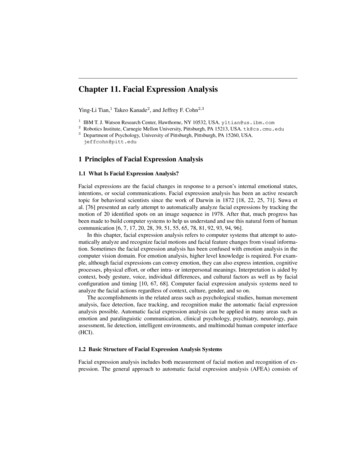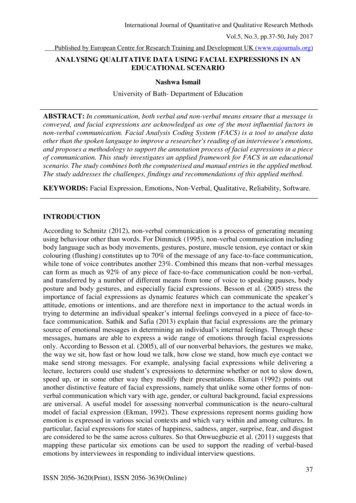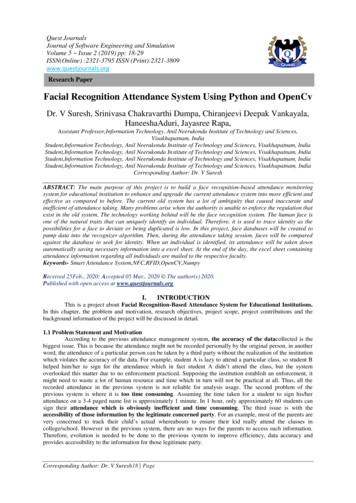
Transcription
FACIALRECOGNITIONFOR A DEBATE LIVINGUP TO THE CHALLENGESEnglish translation - Only the original French version is deemed authenticFacial recognition is raising new questions about societal choices and, as such, interestin the subject is growing on national, European and global public agendas alike. In2018, the CNIL therefore called for attention to be paid to this topic as part of a widerdemocratic debate on the new uses of video assisted technologies. Today, the CNILwould like to contribute to this debate by presenting the technical, legal and ethicalaspects which must, in its view, be borne in mind when addressing this complex issue.Introduction .2I – Facial recognition: what is it exactly? .31.Facial recognition is a biometric face-recognition technology . 32.Facial recognition is not synonymous with “smart” video . 43.Behind the catch-all term, there are multiple cases of use . 4II – The impacts of facial recognition: what are the risks of this technology? . 61.Highly sensitive data that are subject to special protection . 62.A contactless and potentially ubiquitous technology . 73.An unprecedented surveillance potential, capable of undermining societal choices. 74.Fallible and costly technologies that require a clear and comprehensive assessment .8III – Should we experiment with facial recognition? Within a defined framework andmethodically . 91.First requirement: draw some red lines, even before any experimental use. 92.Second requirement: put respect for people at the heart of the approach . 103.Third requirement: adopt a genuinely experimental approach . 10IV – What role will the CNIL play in regulating facial recognition? . 11November 15th, 20191
IntroductionOver a year ago now, the CNIL called for a democratic debate to be held on the new uses of videocameras, with a particular focus on facial recognition technologies. Amid an increase in their useand the public authorities’ growing awareness of the opportunities and risks they pose, this technology has risento the top of the public agenda.This debate is crucial. Indeed, beyond its technicality, political choices have to be made in orderto shape what our society will look like tomorrow: given the power of this technology, how can wereconcile the protection of fundamental rights and freedoms with security or economic considerations?Safeguard anonymity in the public space? Define what forms of surveillance are acceptable in a democraticsociety?Such choices cannot be made behind closed doors, without democratic control, in fits and starts or bytaking ad-hoc initiatives tailored to local contexts, with no overall perspective. Otherwise, there is a considerablerisk that these choices will be lost, that gradual shifts will result in unexpected and unwanted societal changeand that we will one day be faced with a fait accompli. Political choice should not be dictated simply by technicalpossibilities. And neither should the political debate be limited to the question of how to make certain digitaltransformations "acceptable" to our fellow citizens. No. The role of "politics" is to determine which of the possibleuses of these technologies are really desirable, leaving the issue of acceptability until the end of the analysis – asa final step rather than as a postulate.Holding this debate in France also allows our country to contribute from a position of strengthto a Europe-wide and worldwide debate, and freely choose its digital society model. In light of thesometimes unfettered and unreasonable uses of facial recognition around the world, we must build a fullyfledged European model. The moratorium adopted in San Francisco – the heartlands of a California at theforefront of digital transformation – symbolises one thing at least: that vigilance, in respect of facial recognition,is not a secondary concern.This proactive and forward-looking debate must meaningfully address the issues at stake. TheCNIL would like to make an initial contribution to this debate today, primarily in terms of method.To ensure an informed debate, the terms of the debate must themselves be clear, with anunderstanding of what facial recognition means. This will avoid confusion between different uses of thistechnology where the issues raised are not the same, or with related technologies of a different nature (I). Then,the risks associated with this technology must be measured, so that our democratic society can clearlydecide which of them it will refuse and which it will assume with appropriate safeguards (II). This debate alsofalls within a very specific legal framework, within which any use – even experimental – of facial recognitionmust also fall: the European framework protecting the personal data of our fellow citizens, updated by theGeneral Data Protection Regulation (GDPR) and the Data Protection Law Enforcement Directive of 27 April2016 (III). Finally, the CNIL wishes to underscore the advisory and monitoring role it plays and will continue toplay fully, and independently, in the roll-out of these technologies (IV).November 15th, 20192
I – Facial recognition: what is it exactly?The current debate is sometimes distorted by a poor grasp of this technology and of how itexactly works. This can lead to the risks being inadequately described and to confusions betweenfacial recognition and related technologies which also use images at the core of their processing.Another problem arises due to "facial recognition" being referred to in the singular, when it isactually used in many different ways – and the issues involved may vary accordingly, forexample in terms of the control people have over their data. By extrapolating from wellestablished cases of use, there is a high risk of jumping to conclusions about this technology.1. Facial recognition is a biometric face-recognition technologyFacial recognition is a probabilistic software application that can automatically recognise a person basedon its facial attributes in order to authenticate or identify them.Facial recognition falls into the broader category of biometric technology. Biometrics include allautomated processes used to recognise an individual by quantifying their physical, physiological or behaviouralcharacteristics (fingerprints, blood vessel patterns, iris structure, etc.). The GDPR defines these characteristicsas "biometric data", because they allow or confirm the unique identification of that person.This is the case with people’s faces or, more specifically, their technical processing using facial recognitiondevices: by taking the image of a face (a photograph or video), it is possible to produce a digital representationof distinct characteristics of this face (this is called a "template"). This template is supposed to be unique andspecific to each person and it is, in principle, permanent over time. In the recognition phase, the device thencompares this template with other templates previously produced or calculated directly from faces found on animage, photo or video. "Facial recognition" is therefore a two-step process: the collection of the face and itstransformation into a template, followed by the recognition of this face by comparing thecorresponding template with one or more other templates.Like any biometric process, facial recognition can fulfil two distinct functions:the authentication of a person, aimed at checking that a person is who they claim to be. In this case,the system will compare a pre-recorded biometric template (for example, stored on a smart card) with asingle face, such as that of a person turning up at a checkpoint, in order to verify whether this is one and thesame person. This functionality therefore relies on the comparison of two templates.the identification of a person, aimed at finding a person among a group of individuals, in a place, animage or a database. In this case, the system must carry out a test on each face captured to generate abiometric template and check whether it matches a person known to the system. This functionality thusrelies on comparing one template with a database of templates. For example, it can link a "civil status"(surname, first name) to a face, if the comparison is made against a database of photographs associated witha surname and first name. It can also involve following a person through a crowd, without necessarilymaking the link with the person’s civil status.In both cases, the facial recognition techniques used are based on an estimated match between templates: theone being compared and the baseline(s). From this point of view, they are probabilistic. From the comparison,a higher or lower probability is deduced that the person is indeed the person to be authenticated or identified;if this probability exceeds a certain threshold pre-determined in the system, the system will assume there is amatch.November 15th, 20193
2. Facial recognition is not synonymous with “smart” videoFacial recognition is part of a wider spectrum of video image processing techniques. CCTV systemscan film people within a defined area, in particular their faces, but they cannot be used as such to automaticallyrecognise individuals. The same applies to simple photography: a camera is not a facial recognition systembecause photographs of people need to be processed in a specific way in order to extract biometric data.The mere detection of faces by so-called "smart" cameras does not constitute a facial recognition system either.While their use also raise important questions in terms of ethics and effectiveness, digital techniques for detectingabnormal behaviours or violent events, or for recognising facial emotions or even silhouettes, are not typically biometricsystems.These examples are not completely unrelated to facial recognition, however. They can be used in conjunctionwith other systems. Indeed, unlike video capture and processing systems, for example, which require theinstallation of physical devices, facial recognition is a software functionality which can be implemented withinexisting systems (cameras, image databases, etc.). Such functionality can therefore be connected or interfacedwith a multitude of systems, and combined with other functionalities.The debate on facial recognition must take this technological continuum into account. We mustnot use unnecessarily intrusive technologies to tackle specific operational needs, since there may be techniquesor measures with a lesser impact that would be equally, if not more, effective. But the possibility ofcombining these different systems in practice, with the effect of increasing their impact onpeople, must also be considered.3. Behind the catch-all term, there are multiple cases of useFacial recognition can be used for a wide variety of purposes, both for commercial purposes and to addresspublic safety concerns. It can be applied in many different contexts: in the personal relationship between a userand a service (access to an application), for access to a specific place (physical filtering), or without any particularlimitation in the public space (live facial recognition). It can be for anyone: a customer of a service, an employee,a simple onlooker, a wanted person or someone implicated in legal or administrative proceedings, etc. Someuses are already commonplace and widespread; others are, at this point (in France at least), at the planning orspeculative stage, or even absent from the debate altogether.More specifically, if we look at the range of potential uses, a scale might be considered dependingon the degree of control people have over their personal data, the consequences for them (in thecase of recognition or non-recognition) and the scale of the processing carried out. Facialrecognition based on a template stored on a personal device (smart card, smartphone, etc.) belonging to theperson, used for authentication purposes, for strictly personal use and using a dedicated interface, does not posethe same issues as a use for identification purposes, in an uncontrolled environment, without the activeinvolvement of individuals, where the template of each person entering the cameras’ field of view is comparedwith templates from a broad cross-section of the population stored in a database. Between these two extremeslies a very varied spectrum of uses and associated issues.Some uses are designed for users to have full control over them. Authentication can enable access toservices or applications purely in the course of a household activity, for example. As such it is usedextensively by smartphone owners to unlock their device, in place of password authentication.Facial recognition authentication can also be used to check the identity of someone hoping to benefitfrom public or private third party services. This is the case, for example, with the ALICEM system, whichis based on a comparison between a "selfie" and a video taken in real time by the user on one hand, and on the other,the photograph stored in the electronic component of the biometric passport or residence permit belonging tothe same person. This process thus offers a way of creating a digital identity using a mobile app (smartphone,tablet, etc.) which can then be used to securely access online administrative services.November 15th, 20194
As far as accessing commercial services is concerned, biometric authentication can be harnessed to open a bankaccount remotely for example. In this case, the biometric template calculated by processing an identityphotograph submitted by the bank customer is compared with a photographic self-portrait of that person.Authentication can also be used to control physical access to one or more predetermined locations, such asentrances to buildings or specific crossing points. This functionality is, for example, implemented in the PARAFEprocessing of border crossings, where the photograph of the person at the checkpoint device is compared withthe one stored in their identity document (passport or secure residence permit).Identification can be applied in many, even more diverse ways. These particularly include the following uses,currently observed or planned in France or other parts of Europe:automatic recognition of people in an image to identify, for example, their relationships on a socialnetwork such as Facebook, which uses it. The image is compared with the templates of everyone on thenetwork who has consented to this functionality in order to suggest the nominative identification of theserelationships;access to services, with some cash dispensers recognising their customers, by comparing a face capturedby a camera with the database of faces held by the bank;tracking of a transport service passenger’s journey at each stage of the journey. The template,calculated in real time, of any person checking in at gates located at certain stages of the journey (baggagedrop-off points, boarding gates, etc.), is compared with the templates of people previously registered in thesystem;searching, in a database of photographs, for the civil status of an unidentified person (victim,suspect, etc.). This is done with the TAJ system (the processing of criminal records file in France) forexample;monitoring of a person’s movements in the public space. Their face is compared with the biometrictemplates of people travelling or having travelled in the monitored area, for example when a piece of luggageis left behind or after a crime has been committed;reconstructing a person’s journey and their subsequent interactions with third parties, through adelayed comparison of the same elements in a bid to identify their contacts for example;identification of wanted persons in public spaces. All faces captured live by video-protectioncameras are cross-checked, in real time, against a database held by the security forces.These are only examples of applications or projects currently observed or planned in France and Europe, forwhich compliance with the legal framework may not therefore have been assessed yet, in particular for some ofthe identification systems afore mentioned. Yet potential use of facial recognition is even much wider. As a matterof fact, some other countries use facial recognition to enforce traffic offences concerning pedestrians via CCTVsurveillance, or to combat fraud. Others even automatically identify everyone moving along in public spaces.In this context, a use-by-use approach must be applied. This methodology has been required since 1978in France and was reaffirmed in 2016 at the European level by the fundamental texts on data protection: todetermine whether the processing of personal data is lawful, it is necessary to start from its purpose, from theaim pursued. It is only in the context of a specific purpose that it is possible to assess whether the data is relevantand proportionate, whether the retention periods are appropriate, whether security is adequate, etc. What thismeans is that, although there may be lawful and legitimate cases for the use of facial recognition,it should not be considered desirable or possible in all cases.November 15th, 20195
II - The impacts of facial recognition: what are the risks of thistechnology?The risks actually posed by this technology need to be accurately assessed in order to managethem effectively and even refuse certain uses. The GDPR and French Data Protection Act maywell be "technologically neutral" texts, but their application in practice should not ignore thesignificance of these risks, from those shared with other biometric techniques to the morespecific risks of facial recognition, such as the decline of anonymity in the public space.1. Highly sensitive data that are subject to special protectionData protection legislation defines biometric data as "sensitive" data, just as data concerning healthor sex life, political opinions and religious beliefs or genetic data. This shows a new stance on the part ofthe European legislator: biometric data processing did not used to be classified as sensitive, but the GDPRand Data Protection Law Enforcement Directive have revised its status to take full account of the risks posed inits processing.Like other sensitive data, biometric data relates to people’s privacy. It is distinctive in that it allows the datasubject to be identified at any time based on a biological fact specific to them, permanent over timeand from which they cannot be dissociated.Unlike any other personal data, biometric data is not attributed by a third party or even chosen by the datasubject: it is produced by the body itself and designates or represents it and it alone, in an immutable way.Therefore, it cannot be considered as a password or a login, which can be changed if compromised (loss, systemintrusion, etc.): it is non-revocable. Any misappropriation or misuse of this data thus entails substantial risksfor the person from whom it originates: denial of access to services or places, identity theft for fraudulent oreven criminal purposes, etc.Like other biometric techniques, facial recognition is therefore never a completely harmlesstype of processing. Even legitimate and well-defined use can, in the event of a cyber-attack or a simple error,have particularly serious consequences. In this context, the question of securing biometric data is crucialand must be an overriding priority in the design of any project of this kind. The storage of biometric data on apersonal device belonging to and accessible to the user should always be prioritised over central database storagesolutions, in order to minimise the risks involved. Only in cases of absolute necessity and in the absence of anyalternative may centralised storage be considered, subject to strict security measures.For these reasons, biometric processing, including facial recognition, is subject to a strict legalframework that has been reinforced by recent European texts. In the GDPR, the principle is toprohibit such processing. These data may only be processed, by way of exception, in certain specific cases (withthe explicit consent of individuals, to protect their vital interests or on the basis of a substantial public interest)and with appropriate safeguards adapted to these risks. The Data Protection Law Enforcement Directive followsthe same logic, only allowing such data to be processed in cases of absolute necessity. The French Act of 20 June2018, amending the Data Protection Act, is in line with European texts. In the absence of consent, an operator,whether public or private, may only implement biometric processing if it has first been authorised by law.November 15th, 20196
2. A contactless and potentially ubiquitous technologyUnlike other data which is processed biometrically, facial recognition data can, potentially, be obtainedeverywhere. People’s faces are collected and registered in a multitude of widely available databases, whichthus keep track of people’s movements through time and space, therefore constituting a potential source ofcomparison for any facial recognition system. More generally, any photograph can potentially become a pieceof biometric data with more or less straightforward technical processing.This dissemination of data used by facial recognition devices is also taking place amid a context of permanentself-exposure on social media and, more generally, of porosity between household, private and public uses ofthis data. This gives us an idea of the sheer amount of data that is technically accessible and can potentially bemobilised for facial recognition-based identification. Facial recognition is altogether specific in this respect.Facial recognition can also be used as a "contactless" system, with some devices completely removing themachine from the user’s field of vision. It allows the remote processing of data without a person’sknowledge. This is not the case for all uses (unlocking a smartphone, and, more generally, most authenticationuses), but it can allow real-time tracking of everyone’s movements, without any interaction with the person andtherefore without their even being aware of it. From a technical point of view, facial recognition thus allows whatno other technology currently allows or has ever allowed: recognition of a person without any action on theirpart – either at the time of registration or comparison – or even identification of such a person by name, withoutthe owner of the device ever having had any relationship with that person.At a time when the advantages of “seamless" technologies and "fluidity of services" are being extolled, it shouldbe remembered that some form of conscious interaction or effort can be useful. This can help to remind peopleof the reality and consequences of their interactions with digital tools. It can also provide anopportunity for people to assert their rights.3. An unprecedented surveillance potential, capable of underminingsocietal choicesFacial recognition systems can interface easily with all sorts of video devices. There are already manyimage-capture devices embedded in our day-to-day routines. Video surveillance devices, smartphonesand advertising screens are all examples of systems that could potentially be turned into tools for anunprecedented level of surveillance – in the generic sense of the term (sovereign or private). It is not unthinkablethat these image-capture devices, which are potentially compatible with any facial recognition system, mightalso be coupled with other types of technology, such as sound capture – which would further increase the levelof surveillance of people and places. This technological shift is happening in tandem with a shift of thesurveillance paradigm, already in evidence in many areas, where targeted surveillance of certainindividuals has progressed onto a massive surveillance for the purposes of identifying certainindividuals. The replacement of humans with algorithmic processing to carry out identity checks is in itselfaltering the potential for surveillance. The changing nature of surveillance, which is becoming indiscriminate,can, moreover, be seen in the use of facial recognition in the public space via video surveillance cameras.Identifying a person in public spaces requires the biometric processing of everyone moving along in the publicspace under surveillance – templates must be generated for everyone in order to find the wanted person bycomparison.The most advanced uses of facial recognition therefore pose an obvious risk to anonymity in the publicspace. Whether physical or digital, the public space is somewhere many individual and public freedoms areexercised, including the right to privacy and personal data protection, the freedom of expression and assembly,the right to protest, the freedom of conscience and the freedom of religion. This anonymity is protected by law:there is no rule that says everyone must be identified or identify themselves whenever they move in the publicspace. While there are some prohibitions in this respect (ban on concealing one’s face) and some obligations(such as wearing a badge in certain places or being required to submit to controls, verifications and identitychecks), these measures are specifically regulated by law and in no way undermine the possibility for anonymityin public spaces. Erosion of this anonymity, by public authorities or private organisations, is thus likely tojeopardise some of our fundamental principles and therefore calls for careful consideration.November 15th, 20197
Feedback, particularly abroad, shows that facial recognition in the public space can end up making harmlessbehaviour look suspicious. Wearing a hood, sunglasses or a cap, looking at your telephone or at the ground, canhave an impact on the effectiveness of these devices and serve as a basis for suspicion in itself.All of these impacts must be weighed carefully, since some technological developments may wellend up quietly redefining how we are allowed to behave in society.4. Fallible and costly technologies that require a clear andcomprehensive assessmentLike any biometric processing, facial recognition is based on statistical estimates of the matchbetween the elements being compared. It is therefore inherently fallible. The response provided by a biometriccomparison system is never binary (yes or no); it is a probability of match. Furthermore, the biometric templatescalculated are always different depending on the conditions under which they are calculated (lighting, angle,image quality, resolution of the face, etc.). Every device therefore exhibits variable performance according, onthe one hand, to its aims, and, on the other hand, to the conditions for collecting the faces being compared.Like other similar techniques, facial recognition thus inevitably leads to "false positives" (a person is wronglyidentified) and "false negatives" (the system does not recognise a person who ought to be recognised). Dependingon the quality and configuration of the device, the rate of false positives and false negatives may vary. Moreover,these settings can lead to knock-on effects which need to be borne in mind. Imagine that precedence is given toreducing "false negatives", for national security purposes (such as counter-terrorism). This may end up increasingthe number of "false positives", i.e. people who are likely to be wrongly identified as suspects (with the downsidesthat this entails). This variation in performance can thus have far-reaching consequences for peoplewho are mis-identified by the device. The practical questions this raises need to be taken seriously fordefining applications and the measures to be implemented as a result. Operators’ choices when configuring thesesystems are therefore of the utmost importance.Furthermore, there is a significant element of bias inherent in this technology: trials conducted inFrance and other countries have, for example, demonstrated that the error rates of facial recognition algorithmscan vary with gender or skin colour. Even if steps – not least the self-configuration of algorithms – can be takento reduce such bias, the very nature of biometric processing, regardless of the degree of maturity of thetechnology, means that bias will inevitably continue to be observed.These insurmountable technical limitations can seem at odds with the hype and fascination surroundinga technology that is sometimes wrongly perceived or presented as infallible. And yet they must be factored intothe necessary investment choices, in both budgetary and societal terms, when considering whether or not to usefacial recognition.The economic cost of facial recognition devices must be very accurately documented in this respect. It mostoften rests with public authorities or local government, in a global context of streamlining public expenditure,without the return on investment always being measured accurately or methodically. These cos
installation of physical devices, facial recognition is a software functionality which can be implemented within existing systems (cameras, image databases, etc.). Such functionality can t










